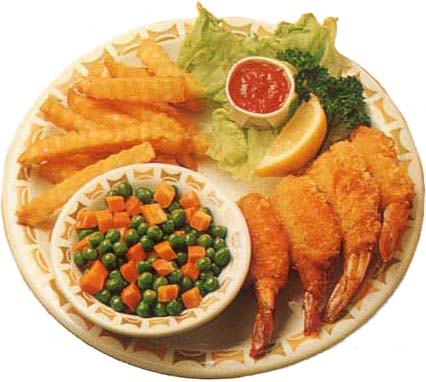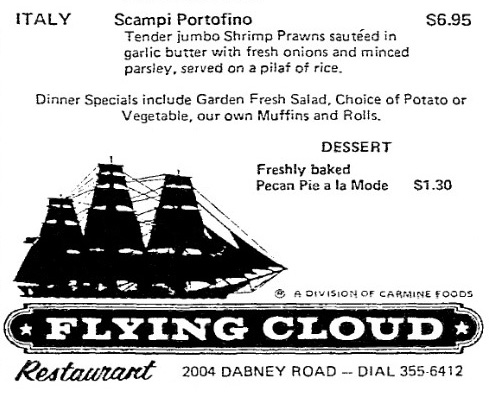 Recently I heard that a shortage of shrimp due to disease is causing prices to shoot up. I stopped to wonder how long shrimp had been on American restaurant menus. I could find no instances before the Civil War.
Recently I heard that a shortage of shrimp due to disease is causing prices to shoot up. I stopped to wonder how long shrimp had been on American restaurant menus. I could find no instances before the Civil War.
Americans have probably been eating shrimp at home for centuries but shrimp didn’t make a splash in American cookbooks until after the Civil War when they became available in cans. Shrimp salad, usually whole shrimp piled up on lettuce with a mayonnaise dressing, became something of a delicacy that was especially popular with women. It began to show up on hotel menus as well.
 Shrimp cocktail, not really so different than shrimp salad, became a staple of banquets in the early 20th century. Instead of mayonnaise a cocktail sauce was used; it was similar or the same as oyster sauce and based on catsup with ingredients such as lemon or vinegar, tabasco or Worcestershire sauce, and horseradish added to give it zing.
Shrimp cocktail, not really so different than shrimp salad, became a staple of banquets in the early 20th century. Instead of mayonnaise a cocktail sauce was used; it was similar or the same as oyster sauce and based on catsup with ingredients such as lemon or vinegar, tabasco or Worcestershire sauce, and horseradish added to give it zing.
Fried shrimp seems to have become a menu item in the early 20th century also, but breaded, deep fried shrimp did not make its big debut until after World War II when pre-cooked frozen shrimp, plain or breaded, came on the market. Then shrimp dinners, relatively cheap because the breading could cover less desirable specimens, became available everywhere, even in many drive-ins.
Until the advent of frozen shrimp, shrimp cocktail and fried shrimp were found most often on menus of restaurants in the Gulf states and California. In the late 19th and early 20th century locally caught shrimp were so plentiful in San Francisco that it was the custom for restaurants to present diners with a free plate of shrimp to nibble on before their meal was delivered.
Importation of shrimp from Mexico and India began in the early 1950s, but evidently it took some time before prices went down. Shrimp cocktail remained a minor luxury for many people through the 1960s. The cost of shrimp was high enough in the mid-1950s to make the theft of frozen shrimp a serious issue for New York’s Mamma Leone’s, which lost thousands of dollars worth of $1.12/lb shrimp to a ring of thieves. The thieves turned out to be a pantry man colluding with garbage collectors who resold the shrimp to other restaurants.
In today’s dollars Mamma Leone’s shrimp cost close to $10/lb, but in actuality prices are much lower than that now due to shrimp farms in Asia and Ecuador that supply most of what Americans eat in restaurants.
 One last note, on the distinction among shrimp, scampi, and prawns. This could launch a long discussion about how many species of shrimp there are, what they are called in various parts of the world, etc. But for all practical purposes, in standard menu-ese scampi, often given as “shrimp scampi” on menus, refers to shrimp cooked in butter and garlic and prawns are very large or “jumbo” shrimp. Sometimes the terms are bizarrely combined on menus. The finest example of this I’ve seen was a 1977 Richmond VA menu partially shown above. For an International Seafood Festival it offered an Italian special called Scampi Portofino which was described as “Jumbo Shrimp Prawns.” I guess those were really, really big shrimp-style shrimp.
One last note, on the distinction among shrimp, scampi, and prawns. This could launch a long discussion about how many species of shrimp there are, what they are called in various parts of the world, etc. But for all practical purposes, in standard menu-ese scampi, often given as “shrimp scampi” on menus, refers to shrimp cooked in butter and garlic and prawns are very large or “jumbo” shrimp. Sometimes the terms are bizarrely combined on menus. The finest example of this I’ve seen was a 1977 Richmond VA menu partially shown above. For an International Seafood Festival it offered an Italian special called Scampi Portofino which was described as “Jumbo Shrimp Prawns.” I guess those were really, really big shrimp-style shrimp.
© Jan Whitaker, 2014













 It's great to hear from readers and I take time to answer queries. I can't always find what you are looking for, but I do appreciate getting thank yous no matter what the outcome.
It's great to hear from readers and I take time to answer queries. I can't always find what you are looking for, but I do appreciate getting thank yous no matter what the outcome.



There’s an alternate, precursor version of shrimp cocktail, which is shrimp in a light, spicy tomato juice, like a Bloody Mary mix. It helps explain the odd use of cocktail to describe it, and you can still find it on the menu at the historic Mission Inn, in Riverside, CA.
About the ubiquity of deep-fried breaded shrimp in the late 50s or early 60s–the first shrimp I remember having was “21 shrimp in a basket” at an A&W Root Beer drive-in about that time. Not much more expensive than a burger and fries, or I wouldn’t have asked for it. I was somewhere about ten-years-old.
This is interesting, especially when we also consider the fact that crab and lobster were once everyday fare but are now considered haute cuisine (particularly crabcakes, which amuses me since their being available canned means we eat them pretty regularly here at home!).
That carries over to many foods- notably oysters! With overfishing a problem in many places around the world, a lot of other seafood could end up the same, alas.
Interesting that shrimp salad was more of a women’s dish. I suppose that it was easy to eat without having to use a knife (as opposed to a dish like steak) and was not likely to leave juices running down one’s chin and thus allowed women to remain feminine (dainty?) while eating in public.
Good points. Also women were supposed not to like meat with blood.